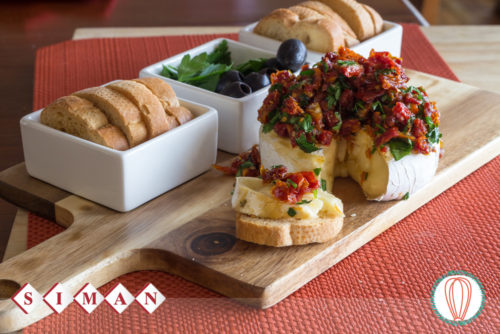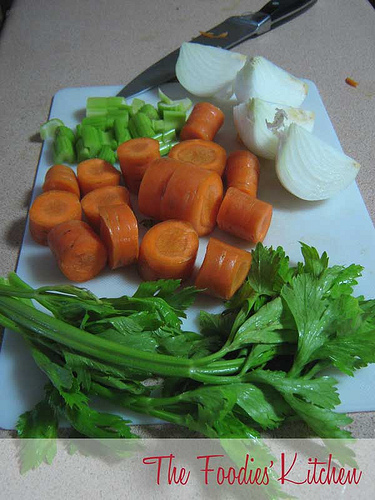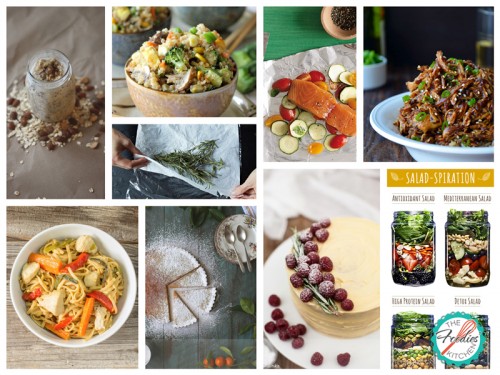Cooking Glossary Terms
This post is also available in ENGLISH (INGLÉS)
At The Foodies’ Kitchen, we know that often you can find terms you’re not familiar with while cooking. We are putting together several Cooking Term Glossaries for you. Here is the first one of the batch. Feel free to comment on the post and let us know what other cooking terms you want to find out and have them handy.
Kitty
- Bake: Cook in oven surrounded by dry heat. Bake uncovered for dry crispy surfaces (breads, cakes, cookies, chicken) or covered for moistness (vegetables, casseroles, stews).
- Baste: Spoon liquid over food (over turkey) during it’s cooking to keep it moist.
- Batter: Uncooked mixture of flour, eggs and liquids with other ingredients, thin enough to be spooned or poured (pancakes, muffins).
- Blanch: Plunge food into boiling water for a brief time to preserve color, texture and nutritional value or to remove skin (vegetables, fruits, nuts).
- Boil: Heat liquid until bubbles rise continuously and break on the surface and steam is given off. For rolling boil, the bubbles form rapidly.
- Broil: Cook directly under or above a red hot heating unit.
- Caramelize: Melt sugar slowly over low heat until it becomes a golden brown, caramel flavored syrup. Or sprinkle granulated, powdered or brown sugar on top of a food, then place under a broiler until the sugar is melted and caramelized.
- Chop: Cut into coarse or fine irregular pieces, using a knife, food chopper, blender or food processor.
- Coat: Cover food evenly with crumbs or sauce.
- Cool: Allow hot food to stand at room temperature for a specific amount of time. Placing hot food on a wire rack will help it to cool more quickly. Stirring mixtures occasionally also will help them cool more quickly and evenly.
- Core: Remove a center of a fruit (apple, pear, pineapple). Core contain small seeds (apple, pear) or are woody texture (pineapple).
- Crisp Tender: Doneness description of vegetables cooked until they retain some of the crisp texture of raw food.
- Crush: Press into very fine particles (crushing a clove of garlic, using chef’s knife or garlic press).
- Cube: Cut food into squares 1/2 inch or larger, using a knife.
- Cut Up: Cut into small irregular pieces with kitchen scissors or knife. Or cut into smaller pieces (broiler fryer chicken).
- Dash: Less than 1/8 teaspoon of an ingredient.
- Deep Fry/French Fry: Cook in hot fat that’s deep enough to float the food.
- Dice: Cut food into squares smaller than 1/2 inch, using knife.
- Dissolve: Stir a dry ingredient (flavored gelatin) into a liquid ingredient (boiling water) until the dry ingredient disappears.
- Dot: Drop small pieces of an ingredient (margarine or butter) randomly over food (sliced apples in an apple pie).
- Dough: Mixture of flour and liquid and other ingredients, producing a pliable mixture for making baked goods.
- Drain: To allow a liquid to withdraw from, pour out of, or pour off an item, sometimes with the use of a strainer or colander.
- Drizzle: To slowly pour a liquid mixture in a very fine stream over food.
- Dust: There are two terms for Dust, the first in cooking, this term refers to lightly coating a food with a powdery ingredient such as flour or confectioners’ sugar. The second one, is term used to describe inferior, coarsely crushed tea leaves.
- Flake: To use a utensil (usually a fork) to break off small pieces or layers of food.
- Flute: Create a decorative scalloped edge on a pie crust or pastry. Also mushrooms and vegetables are fluted to give them an attractive cut and rolled symmetric edging.
- Fry: Cook food in fat over moderate to high heat.
- Glaze: Give food a shiny surface by brushing it with sauce, aspic or icing. When talking about meat, means to coat with sauce and then brown in an oven.
- Grate: To rub or wear into small particles, by rubbing on the rough surface of a grater.
- Grease: To spread fat (or non-stick cooking spray) on a cooking utensil or pan to prevent food from sticking.
- Grease and Flour: Is to grease the pan then dust with flour. The flour is sprinkled into the greased pan then the pan is shaken to distribute evenly before inverting and discarding the excess.
- Grill: To cook on a rack directly over hot coals or other heat source.
- Julienne: Cut vegetables such as carrots or potatoes into even slices then thin sticks, with a knife.
- Knead: To manipulate dough in order to develop the gluten. This is done using a pressing motion with folding and stretching. For yeast breads: Fold the dough toward you, then push the dough away using the heel of your hand. Rotate the ball of dough 1/4 turn and repeat the action. Continue this motion for several minutes until the dough becomes more elastic or as long as your recipe states. Kneading biscuit dough is done more gently and for less time.
- Marinate: To let food stand in seasonings that include at least one wet ingredient to tenderize and increase the flavor.
- Mince: To chop foods very finely into small pieces.
- Pan-Fry: Cook in an uncovered skillet in small amount of shortening.
- Peel: Strip off an outer covering or skin of a fruit or vegetable.
- Poach: Food submerged and cooked in a liquid that is barely simmering or shivering. The term can also be used poetically for such things as “chicken breasts poached on butter”.
- Pre Heat: Bring the oven or grill to the desired temperature before placing the food. This is a crucial step on preparing recipes, specially baking.
- Reduce: To boil down a liquid, reducing its quantity and concentrating its taste.
- Roast: A dry cooking process in the oven or on a spit with a small amount of fat, usually refers to meat.
- Sauté: Cook and brown food in a very small quantity of very hot fat, usually in an open skillet.
- Scald: There are two meanings for Scald. First, would be to heat milk to just below the boiling point. Second, means to dip fruits, vegetables, or nuts in boiling water to facilitate removing the skin or shell.
- Score: Tenderize meat, fish or shellfish by making a number of shallow often diagonal cuts across its surface.
- Shred: Cut food into long, thin strands.
- Simmer: To cook liquid below or just at the boiling point. The bubbles should rise slowly to the surface.
- Slice: To cut food into similar size flat pieces.
- Soft Peaks: When a whisk is removed from a lightly whisked or whipped ingredient e.g. cream or egg whites, the mixture just stands up in points known as soft peaks, e.g. whip the cream until it forms soft peaks.
- Soften: Let cold food stand at room temperature, or microwave at low power setting, until no longer hard, as for butter and cream cheese.
- Steam: To cook over boiling water in a covered pan or to cook in a special pressurized steam compartment.
- Stew: To cook meat and vegetables in liquid just below the boiling point.
- Stiff Peaks: Egg whites beaten until they are stiff enough to stand on their own. They have a glossy moist look when just right, and stand upright when the beater is lifted from the bow.
- Strain: To separate liquid from solid food by pouring through a strainer or fine sieve.
- Tear: Break into pieces with fingers, such as lettuce for a salad or bread slices for soft bread crumbs.
- Toss: To cause a rising and falling action for the purpose of blending ingredients together as in salads.
All the cooking terms on this post, were gathered from different websites: New Italian Recipes, Good Cooking, Net Cooks, Cooking Nook, Cooks Recipes, Cookery Online, What’s Cooking America, Waitrose, Betty Crocker and Epicurious
© 2010 – 2020, The Foodies’ Kitchen. All rights reserved | Todos los derechos reservados
This post is also available in ENGLISH (INGLÉS)



